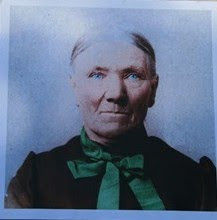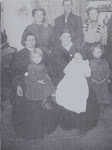As you drive through the peaceful valley north of Preston, Idaho on the scenic US 91, you will see a lovely, peaceful valley with a beautiful river flowing through it.
The River is beautiful and flows quietly through the valley.
Then at Milepost 13.1 you will see a roadside memorial marker, indicating a place that is now a National Historic Site (ID). It is the site of the Bear River Massacre, also known as the Battle of Bear River and the Massacre at Boa Ogoi, took place on January 29, 1863.
There is much written on this tragic event, and much of it is slanted against the Mormon Pioneers living in the valley, mostly perhaps because they were the largest organized group that moved into the lands inhabited by the Northern Shoshone. The Indians were facing starvation because of the lack of food and the strain of a growing population. Brigham Young's philosophy was, "feed them, don't fight them." The Chief was a good man. There was a maurading band that came and stole horses and cattle from the Mormon settlers. The Chief rode north to where the small band was, chastized them for what they had done and brought the animals back. The Chief was warned by Mormon settlers of the soldiers that had arrived in town. But the Chief was not worried. "We are friends with the white man." The Mormons also told the troops that had arrived that the Indians that were in the valley were not the ones that were causing the trouble. They apparently did not care, and the evil and viciousness of this attack is beyond what the mind can conceive. Before dawn on the bitterly cold day of January 29, Shoshone leader Sagwich rose early to survey the area. As he looked to wards the bluffs to the south he observed what seemed to be a mist or for crawling down the bluffs across the river from the camp. Suddenly a company of soldiers on horseback appeared. The alarm was raised in the camp and the Shoshone leaders gathered to parley with the soldiers. However, upon fording the river and seeing the mass of Shoshone, the cavalry opened fire and advanced on the camp. At first they were driven back and several soldiers were killed. Eventually, regrouping and reinforced by the infantry, the soldiers attacked the encampment and what began as a battle quickly became a massacre. The creek bottom, where the Shoshone turned for protection, became instead a trap. Many who were not killed outright drowned while trying to escape in the river. The soldiers, better equipped with guns and ammunition, slaughtered the INdians in hand-to-hand combat. According to the Shoshone, Col. Conner never had any intention of negotiating with their people and arrived with the specific intention of attacking the Indians, leaving them no alternative but death and annihilation.
(double click on images to enlarge)


 The bright green is the "Bear River Massacre Killing Field". The plaque describes the battle. The Historical Memorial was erected July 1953 by the Daughters of the Utah Pioneers. It reads: "Attacks by the Indians on the peaceful inhabitants in this vicinity led to the final battle here January 29, 1863. The conflict occured in deep snow and bitter cold. Scores of wounded and frozen soldiers were taken from the battlefied to the Latter Day Saint community of Franklin. Here Pioneer women, trained through trials and necessity of frontier living accepted the responsibility of caring for the wounded until they could be removed to Camp Douglas, Utah. Two Indian women and three children, found alive after the encounter were given homes in Franklin."
The bright green is the "Bear River Massacre Killing Field". The plaque describes the battle. The Historical Memorial was erected July 1953 by the Daughters of the Utah Pioneers. It reads: "Attacks by the Indians on the peaceful inhabitants in this vicinity led to the final battle here January 29, 1863. The conflict occured in deep snow and bitter cold. Scores of wounded and frozen soldiers were taken from the battlefied to the Latter Day Saint community of Franklin. Here Pioneer women, trained through trials and necessity of frontier living accepted the responsibility of caring for the wounded until they could be removed to Camp Douglas, Utah. Two Indian women and three children, found alive after the encounter were given homes in Franklin." I wish some mention had been made that reflects the relationship between this group of American Indians and the local Mormon families. Maybe it wasn't as good as I like to think it was... but I think it must have been better than portrayed by history.
This is a True Indian Story: a favorite story Louisa told Phoebe Wheeler.
"It was the winter of 1860 in Franklin, Idaho and the Saints were having trouble with the Indians. They were stealing cattle, horses, and giving plenty of trouble. They were told if they didn't get along they would send the army, but the Indians didn't believe them, so the soldiers were sent for and they came one evening. The Pioneers fed them and gave them a good place to sleep. The next morning they fought with the Indians, there were eight soldiers killed and many Indians killed and wounded. All the families in the settlement had to care for the wounded Indians. They put them in buildings and took food, water and medicine to them.
There were two Indians given to great-great-grandmother, Sarah Marshall. Louisa (great-grandmother) was only 10 years old, and her brother George was 8. It was their job to take the food and water to the 2 Indians who were in the blacksmith shop. One of the Indians hands was shot pretty bad so he asked Grandmother if she and Uncle George would get some bark off quaken aspen tree, chokeberry tree, tag elder, and kontnick tree which they did. They put the bark in a big clean pot and cooked it over the fire. When it was done and cooled he put it on his hands and soon they were healed. They kept him the rest of the winter and when spring came let him go back to his tribe. He always called Louisa, Sockopee.
The years passed and grandmother married and had 6 children living in Frankfort on a big farm. Martin Calvin was doing some investigating at the lower field and wanted Louisa to walk around the field with him. There were Indians camped at the lower end of the field. Calvin said Louisa lets walk over and see if we know any of them so they did.
When they got to the camp, an old Indian came forward and said, "Sockopee, Sockopee."
Grandmother didn't know what he was trying to say or recognize him.
Then he held up his two scared hands and she knew he was one of the Indians she helped to care for many years before when she was a small girl, 10 years of age."
Grandmother Delilah Asay told us this story, telling abou the Indian braves that escaped the soldiers hid under the banks of the frozen river and the snow being red with blood. Rick, has many Northern Shoshone friends, and tried to discover what Sokopee meant. Since it is phonetic, the closest translation that makes sense is "Little mother". In any case, this Indian used it as a term of endearment.
(click below to hear Amazing Grace in Cherokee)





















This posting is extraordinary, including the Cherokee site which includes wisdom, photos and music that brings one to tears.
ReplyDelete